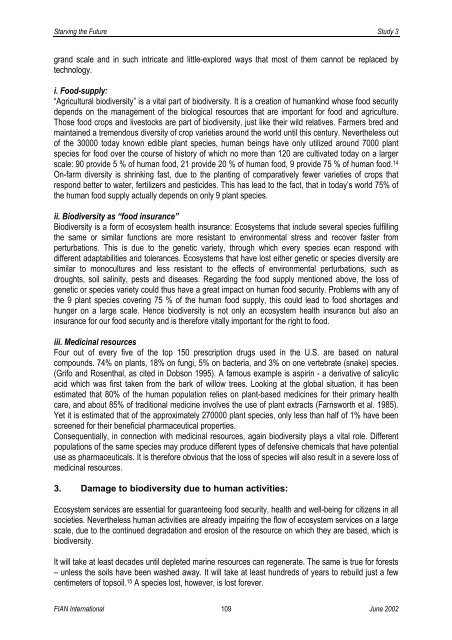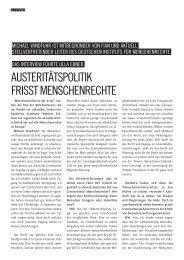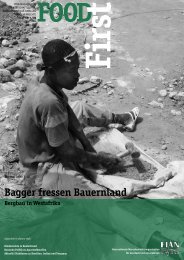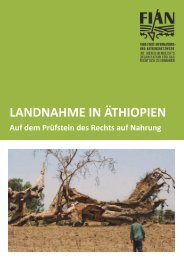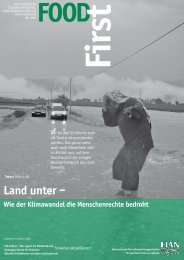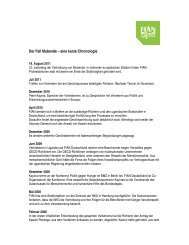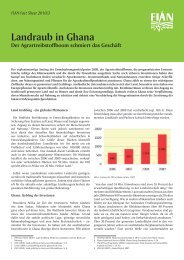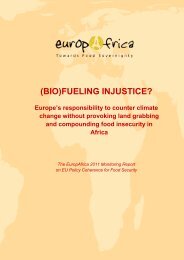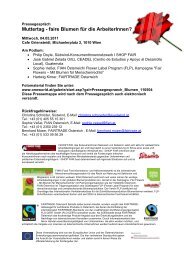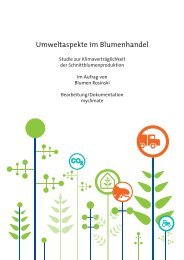Study 3: Ecodestruction and the Right to Food: The Cases of Water ...
Study 3: Ecodestruction and the Right to Food: The Cases of Water ...
Study 3: Ecodestruction and the Right to Food: The Cases of Water ...
You also want an ePaper? Increase the reach of your titles
YUMPU automatically turns print PDFs into web optimized ePapers that Google loves.
Starving <strong>the</strong> Future <strong>Study</strong> 3<br />
gr<strong>and</strong> scale <strong>and</strong> in such intricate <strong>and</strong> little-explored ways that most <strong>of</strong> <strong>the</strong>m cannot be replaced by<br />
technology.<br />
i. <strong>Food</strong>-supply:<br />
“Agricultural biodiversity” is a vital part <strong>of</strong> biodiversity. It is a creation <strong>of</strong> humankind whose food security<br />
depends on <strong>the</strong> management <strong>of</strong> <strong>the</strong> biological resources that are important for food <strong>and</strong> agriculture.<br />
Those food crops <strong>and</strong> lives<strong>to</strong>cks are part <strong>of</strong> biodiversity, just like <strong>the</strong>ir wild relatives. Farmers bred <strong>and</strong><br />
maintained a tremendous diversity <strong>of</strong> crop varieties around <strong>the</strong> world until this century. Never<strong>the</strong>less out<br />
<strong>of</strong> <strong>the</strong> 30000 <strong>to</strong>day known edible plant species, human beings have only utilized around 7000 plant<br />
species for food over <strong>the</strong> course <strong>of</strong> his<strong>to</strong>ry <strong>of</strong> which no more than 120 are cultivated <strong>to</strong>day on a larger<br />
scale: 90 provide 5 % <strong>of</strong> human food, 21 provide 20 % <strong>of</strong> human food, 9 provide 75 % <strong>of</strong> human food. 14<br />
On-farm diversity is shrinking fast, due <strong>to</strong> <strong>the</strong> planting <strong>of</strong> comparatively fewer varieties <strong>of</strong> crops that<br />
respond better <strong>to</strong> water, fertilizers <strong>and</strong> pesticides. This has lead <strong>to</strong> <strong>the</strong> fact, that in <strong>to</strong>day’s world 75% <strong>of</strong><br />
<strong>the</strong> human food supply actually depends on only 9 plant species.<br />
ii. Biodiversity as “food insurance”<br />
Biodiversity is a form <strong>of</strong> ecosystem health insurance: Ecosystems that include several species fulfilling<br />
<strong>the</strong> same or similar functions are more resistant <strong>to</strong> environmental stress <strong>and</strong> recover faster from<br />
perturbations. This is due <strong>to</strong> <strong>the</strong> genetic variety, through which every species ecan respond with<br />
different adaptabilities <strong>and</strong> <strong>to</strong>lerances. Ecosystems that have lost ei<strong>the</strong>r genetic or species diversity are<br />
similar <strong>to</strong> monocultures <strong>and</strong> less resistant <strong>to</strong> <strong>the</strong> effects <strong>of</strong> environmental perturbations, such as<br />
droughts, soil salinity, pests <strong>and</strong> diseases. Regarding <strong>the</strong> food supply mentioned above, <strong>the</strong> loss <strong>of</strong><br />
genetic or species variety could thus have a great impact on human food security. Problems with any <strong>of</strong><br />
<strong>the</strong> 9 plant species covering 75 % <strong>of</strong> <strong>the</strong> human food supply, this could lead <strong>to</strong> food shortages <strong>and</strong><br />
hunger on a large scale. Hence biodiversity is not only an ecosystem health insurance but also an<br />
insurance for our food security <strong>and</strong> is <strong>the</strong>refore vitally important for <strong>the</strong> right <strong>to</strong> food.<br />
iii. Medicinal resources<br />
Four out <strong>of</strong> every five <strong>of</strong> <strong>the</strong> <strong>to</strong>p 150 prescription drugs used in <strong>the</strong> U.S. are based on natural<br />
compounds. 74% on plants, 18% on fungi, 5% on bacteria, <strong>and</strong> 3% on one vertebrate (snake) species.<br />
(Grifo <strong>and</strong> Rosenthal, as cited in Dobson 1995). A famous example is aspirin - a derivative <strong>of</strong> salicylic<br />
acid which was first taken from <strong>the</strong> bark <strong>of</strong> willow trees. Looking at <strong>the</strong> global situation, it has been<br />
estimated that 80% <strong>of</strong> <strong>the</strong> human population relies on plant-based medicines for <strong>the</strong>ir primary health<br />
care, <strong>and</strong> about 85% <strong>of</strong> traditional medicine involves <strong>the</strong> use <strong>of</strong> plant extracts (Farnsworth et al. 1985).<br />
Yet it is estimated that <strong>of</strong> <strong>the</strong> approximately 270000 plant species, only less than half <strong>of</strong> 1% have been<br />
screened for <strong>the</strong>ir beneficial pharmaceutical properties.<br />
Consequentially, in connection with medicinal resources, again biodiversity plays a vital role. Different<br />
populations <strong>of</strong> <strong>the</strong> same species may produce different types <strong>of</strong> defensive chemicals that have potential<br />
use as pharmaceuticals. It is <strong>the</strong>refore obvious that <strong>the</strong> loss <strong>of</strong> species will also result in a severe loss <strong>of</strong><br />
medicinal resources.<br />
3. Damage <strong>to</strong> biodiversity due <strong>to</strong> human activities:<br />
Ecosystem services are essential for guaranteeing food security, health <strong>and</strong> well-being for citizens in all<br />
societies. Never<strong>the</strong>less human activities are already impairing <strong>the</strong> flow <strong>of</strong> ecosystem services on a large<br />
scale, due <strong>to</strong> <strong>the</strong> continued degradation <strong>and</strong> erosion <strong>of</strong> <strong>the</strong> resource on which <strong>the</strong>y are based, which is<br />
biodiversity.<br />
It will take at least decades until depleted marine resources can regenerate. <strong>The</strong> same is true for forests<br />
– unless <strong>the</strong> soils have been washed away. It will take at least hundreds <strong>of</strong> years <strong>to</strong> rebuild just a few<br />
centimeters <strong>of</strong> <strong>to</strong>psoil. 15 A species lost, however, is lost forever.<br />
FIAN International 109<br />
June 2002


